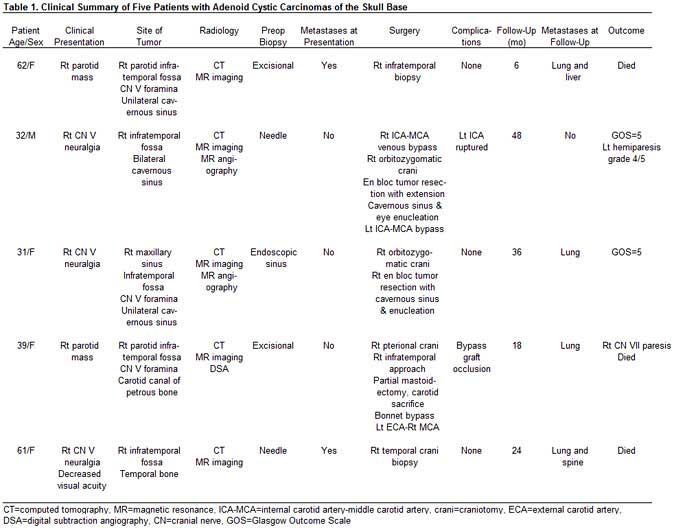
Resection of Adenoid Cystic Carcinomas of the Skull Base: Experience with Five Patients
A. Giancarlo Vishteh, MD†
Trimurti D. Nadkarni, MD‡
Robert F. Spetzler, MD
Division of Neurological Surgery, Barrow Neurological Institute, St. Joseph’s Hospital and Medical Center,
Phoenix, Arizona
Current Address: †Quantum Neurological Surgery, PC, Phoenix, Arizona
‡Department of Neurosurgery, K. E. M. Hospital and Seth G. S. Medical College, Parel, Mumbai, India
Abstract
The management strategies and outcomes of five patients (four females, one male) with adenoid cystic carcinomas of the skull base are presented. Three patients became symptomatic with trigeminal neuralgia. Three patients underwent radical resection, one underwent palliative decompression, and one underwent an open biopsy. The cavernous sinus was infiltrated in four patients and the carotid canal in one. The pterional approach, with and without an orbitozygomatic osteotomy, was used in three patients, and the infratemporal and subtemporal approaches were used in one patient each. Internal carotid artery (ICA) bypasses were used when the cavernous sinus or petrous carotid needed resection (n=3). Management of adenoid cystic carcinomas of the skull base is dictated by tumor staging. Although tumors typically recur after resection and radiotherapy, tumor-free intervals can last 5 to 8 years. Consequently, despite surgical morbidity, radical resection is advocated for young patients with adenoid cystic carcinomas of the skull base without metastases. Revascularization permits more complete tumor resection when the ICA is involved.
Key Words: adenoid cystic carcinomas, skull base
Adenoid cystic carcinomas are malignant epithelial neoplasms that arise from the salivary glands. These carcinomas can involve the nasopharynx, lacrimal glands, lung, trachea, mammary gland, and skin. The tumors are characterized by an insidious, aggressive, and invasive local growth. Distant metastases are common. Perineural spread along the trigeminal nerve and its branches renders the skull base and cavernous sinus susceptible to tumor invasion. Thus, there can be bony (skull base), meningeal, neural, and parenchymal involvement as a result of contiguous or perineural spread via the foramina of the skull base. The reported incidence of intracranial involvement ranges between 3 and 22%.[2,12,14]
Adenoid cystic carcinomas of the skull base are characterized by slow progression. Patients with both advanced local disease and metastases have had long-term survivals.[4] Thus, in the absence of metastases, radical surgery for local disease can be attempted. If tumor-free margins are achieved in the resected specimen, local relapses can be minimized and survivals extended by the addition of radiotherapy.
Local resection of adenoid cystic carcinomas when the carotid artery, skull base, or intracranial regions are involved requires considerable neurosurgical expertise. Skull base surgical techniques combined with revascularization permit gross total tumor resection where indicated. We present our experience with the management of five patients with adenoid cystic carcinomas of the skull base and intracranial involvement.
Five patients (four females, one male) were diagnosed with adenoid cystic carcinomas of the skull base (Table 1). Three patients became symptomatic with trigeminal neuralgia (Fig. 1). Magnetic resonance (MR) imaging and computed tomography (CT) were obtained in all patients, and all patients underwent a preoperative biopsy to confirm their diagnosis. Before surgery was undertaken, an intensive radiological evaluation, which included CT of the lungs and abdomen, plain radiography, and ultrasonography, was obtained to rule out metastases.
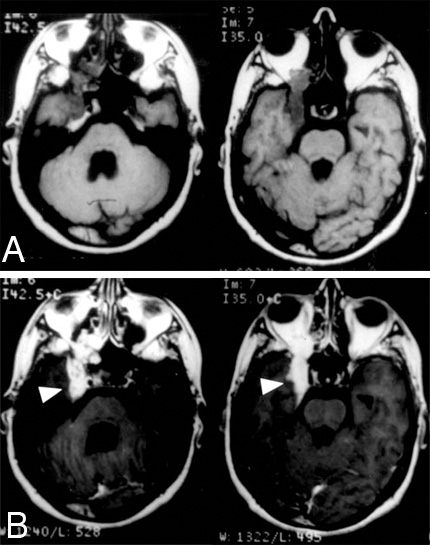
In all cases the carotid artery was involved with the tumor. The cavernous sinus was infiltrated (Fig. 2) in four patients and the carotid canal in one. Carotid artery bypasses were used when resection of the cavernous sinus or petrous internal carotid artery (ICA) was planned (Fig. 3). Three patients underwent radical resection, with a free flap reconstruction of the skull base. One patient underwent a palliative decompression and one an open biopsy. One subtemporal, one infratemporal, and three pterional (with and without orbitozygomatic osteotomies; Fig. 4) approaches were performed. Postoperatively, all patients underwent radiation therapy.
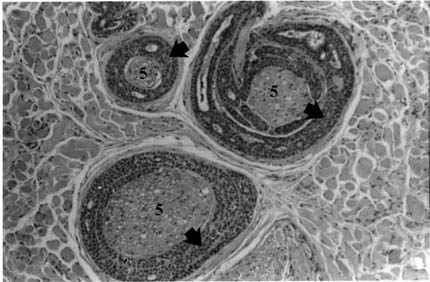
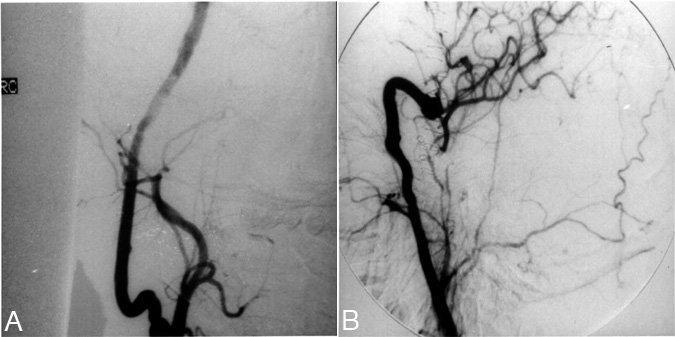
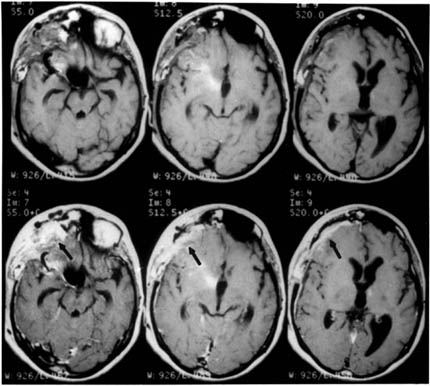
Results
The surgical mortality rate was 0%. Major surgical complications included graft occlusion, a ruptured contralateral ICA, and one case of hemiparesis.
The mean follow-up was 26.4 months (range, 6 to 48 months). Two of the three patients undergoing resection had Glasgow Outcome Scale (GOS) scores of 5 at 48 and 36 months, respectively. One remains free of disease, and the other has developed lung metastases. The third patient (GOS 3) died of metastases 18 months later. The two patients undergoing biopsy or palliative treatment died of metastases at 6 and 24 months, respectively.
Discussion
Adenoid cystic carcinomas of the head and neck with extension into the skull base and intracranial compartment are rare. Otherwise known as cylindromas,[13] these tumors originate from salivary glands (usually the parotid gland) or salivary rests in the head and neck. The primary sites include the nasopharynx, lacrimal gland, parotid gland, submaxillary gland, submandibular gland, minor salivary glands, maxillary sinus, sphenoid sinus, ethmoid sinus, oral cavity, pharynx, tongue, nasal septum, mandible, and upper respiratory airway. Metastatic adenoid carcinomas with primary sites in the lung, breast, and scalp have been reported.[1]
Intracranial extension may occur by contiguity, hematogenous spread, or perineural involvement through the skull base foramina. The sites of intracranial involvement in their decreasing order of incidence are the Gasserian ganglion, temporal lobe or middle fossa, cavernous sinus, frontal lobes or anterior fossa, chiasmal region, cerebellopontine angle, and posterior fossa.[1] Multiple brain metastases from an adenoid cystic carcinoma of the parotid gland have been reported.[5]
Histopathologically, three distinct patterns have been described: cribriform, tubular, and solid.[7] The cells are usually well differentiated with few mitoses and form cylindromatous tissue, hence, their older designation as cylindromas. Perzin et al.[7] noted that the tubular pattern was associated with the best prognoses and predominantly solid tumors with the worst.
Diagnosis and Presentation
Extensive evaluation is needed to determine the presence of primary or metastatic lesions. The nasopharynx and hypopharynx should be examined fiberoptically. Indirect laryngoscopy and mammography are also needed. Contrast MR imaging of the neck should include postcontrast T1-weighted fat-suppressed images. CT scans of the paranasal sinuses and skull base should be obtained in the axial and coronal planes. CT with bone windows detects bone erosion and enlargement of the foramina ovale and rotundum. CT scans of the chest, abdomen, and pelvis should also be obtained. It cannot be overemphasized that the metastatic workup of these patients must be exhaustive and the findings negative before high-risk, labor-intensive surgery is undertaken.
The clinical presentation of these tumors is referable to their anatomic location. Adenoid cystic carcinomas of the skull base are characterized by few symptoms, slow evolution, and multiple recurrences with a protracted clinical course.[4] Typical manifestations include the presence of a painless mass in the neck, trigeminal neuralgia, hemifacial spasm, facial numbness, and ophthalmoplegia.
Surgical Indications
Gormley et al.[4] have recommended palliative (debulking) surgery for patients with large intracranial masses (even when the extent of local disease precludes a surgical cure), for patients in whom microscopic tumor infiltration along cranial nerves is beyond the capacity for resection, and for patients known to have well-controlled metastatic disease. The long-term outcomes achieved by this group demonstrate that many patients can have extended survivals in the presence of both local recurrences and metastatic disease. Thus, the indications for surgical resection for patients with adenoid cystic carcinomas may be different than for those with other types of skull base malignancies. The only absolute contraindications for attempted gross total surgical resection are patients with metastases or those whose general condition is poor.
Treatment
Patients with adenoid cystic carcinomas of the skull base are evaluated and treated jointly by neurosurgeons, otolaryngologists, head and neck physicians, and plastic surgeons. Gormley et al.[4] have reported the largest series of patients primarily managed from a neurosurgical perspective, which is dictated by tumor staging. Although tumor recurrence after resection or radiotherapy is the rule, patients without metastases may be free of tumor for 5 to 8 years. In these patients, gross total surgical extirpation should be attempted because the potential for long-term survival in the absence of distal metastases is high.[13] Vascular bypass, namely, ICA bypass, is an important adjunct for achieving radical tumor resection and hence more complete regional control.
When the ICA is to be sacrificed, it is our philosophy to revascularize the ICA territory in all patients. The balloon occlusion test (BOT) is most unreliable in patients who are to undergo permanent ICA sacrifice (followed by tumor resection) after “passing” the BOT.[8] When a bypass is needed, Gormley et al.[4] recommended a retroauricular-routed cervical-to-M2 saphenous vein bypass graft to avoid both the area of tumor resection and potential postoperative infections related to nasopharyngeal contamination. This strategy allows both cerebral protection and radical tumor resection. In patients whose ipsilateral ICA was occluded as the result of head and neck radiation, we have used a “bonnet” bypass.[8]
When only debulking is planned, tumor should not be resected aggressively from major vessels (i.e., ICA or middle cerebral artery). Because this tumor tends to infiltrate arterial walls, aggressive resection from such vessels can weaken their wall and cause vessels to rupture.
Stage T3 tumors, as described by Shotton et al.,[10] involve the infratemporal fossa. Stage 4 tumors have an intracranial extension and require neurosurgical intervention. Anterolateral skull base approaches with orbitozygomatic osteotomies provide excellent access to the cavernous sinus and Gasserian ganglion with minimal cerebral retraction. Intraorbital extensions can also be tackled. A subtemporal-infratemporal exposure provides access to the infratemporal and pterygopalatine fossae. Depending on the location of the tumor, transfacial approaches can also be used.
Radiation therapy is recommended as an adjunct because adenoid cystic carcinomas of the skull base are radiosensitive but not radiocurable.[3,5,11,13,14] Miller et al.[6] reported that stereotactic radiosurgery using the Leksell gamma knife can provide durable tumor control and symptomatic relief with acceptable morbidity rates in most patients with malignant tumors involving the skull base with diameters of 4 cm or less. Tumors can also shrink after chemotherapy.[9,14]
No studies, however, are available on the natural course of this disease. Spiro et al.[11] found no relationship between histological grade and length of survival although the clinical stage of a tumor appeared to be highly significant. Survival rates at 10 years were 72%, 42%, and 29% in patients with stage 1, 2, and 3 tumors, respectively. Gormley et al.[4] achieved a mean survival of 49 months (range, 6 to 98 months) in patients with highly advanced stages of the disease with large intracranial mass lesions who underwent surgical resection. Thus, the outcome of radical surgery is encouraging in patients with localized disease. Brain stem compression, ICA encasement, cavernous sinus involvement, or orbital involvement present only relative limitations to surgical intervention. Our series reemphasize the observations of Gormley et al.[4]
Conclusion
Despite the trend toward less aggressive surgeries in patients with malignant skull base tumors, adenoid cystic carcinomas remain one of the few exceptions to the rule. Gross total tumor resection supplemented with radiation therapy allows relatively long survival rates in patients without distal metastases. Before such extremely tedious and difficult surgeries are undertaken, however, an in-depth metastatic evaluation must be completed. Ultimately, surgery may be offered to patients whose disease is not advanced and to those whose medical reserve is adequate.
References
- Alleyne CH, Bakay RA, Costigan D, et al: Intracranial adenoid cystic carcinoma: Case report and review of the literature. Surg Neurol 45:265-271, 1996
- Conley J, Dingman DL: Adenoid cystic carcinoma in the head and neck (cylindroma). Arch Otolaryngol 100:81-90, 1974
- Eby LS, Johnson DS, Baker HW: Adenoid cystic carcinoma of the head and neck. Cancer 29:1160-1168, 1972
- Gormley WB, Sekhar LN, Wright DC, et al: Management and long-term outcome of adenoid cystic carcinoma with intracranial extension: A neurosurgical perspective. Neurosurgery 38:1105-1112, 1996
- Hammoud MA, Hassenbusch SJ, Fuller GN, et al: Multiple brain metastases: A rare manifestation of adenoid cystic carcinoma of the parotid gland. J Neurooncol 27:61-64, 1996
- Miller RC, Foote RL, Coffey RJ, et al: The role of stereotactic radiosurgery in the treatment of malignant skull base tumors. Int J Radiat Oncol Biol Phys 39:977-981, 1997
- Perzin KH, Gullane P, Clairmont AC: Adenoid cystic carcinomas arising in salivary glands: A correlation of histologic features and clinical course. Cancer 42:265-282, 1978
- Sekhar LN, Patel SJ: Permanent occlusion of the internal carotid artery during skull-base and vascular surgery: Is it really safe? Am J Otol 14:421-422, 1993
- Sessions RB, Lehane DE, Smith RJ, et al: Intra-arterial cisplatin treatment of adenoid cystic carcinoma. Arch Otolaryngol 108:221-224, 1982
- Shotton JC, Schmid S, Fisch U: The infratemporal fossa approach for adenoid cystic carcinoma of the skull base and nasopharynx. Otolaryngol Clin North Am 24:1445-1464, 1991
- Spiro RH, Huvos AG, Strong EW: Adenoid cystic carcinoma: Factors influencing survival. Am J Surg 138:579-583, 1979
- Variakojis D, Archer FL, Feldman SA, et al: Rapidly progressing adenoid cystic carcinoma. Arch Otolaryngol 92:90-93, 1970
- Vincentelli F, Grisoli F, Leclercq TA, et al: Cylindromas of the base of the skull. Report of four cases. J Neurosurg 65:856-859, 1986
- Wakisaka S, Nonaka A, Morita Y, et al: Adenoid cystic carcinoma with intracranial extension: Report of three cases. Neurosurgery 26:1060-1065, 1990

